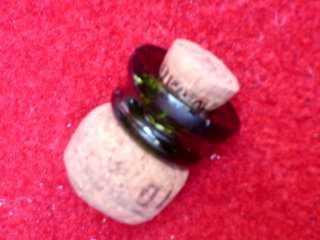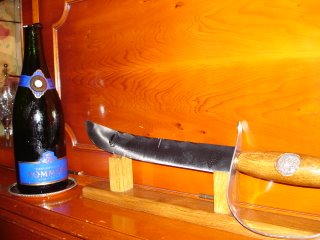
*Sabrage = to sabre the champagne = to take the top of the bottle off with a sabre
 Last night I experienced one of those unique moments in life -- when you do something really exciting for the first time : I 'sabred' a bottle of champagne, i.e. I took the top of the bottle off with the single swoop of a sabre!
Last night I experienced one of those unique moments in life -- when you do something really exciting for the first time : I 'sabred' a bottle of champagne, i.e. I took the top of the bottle off with the single swoop of a sabre!No one can describe that moment! It is exceptionally thrilling to rest a heavy bottle of champagne in one hand, and then, with the single swift movement of the sabre up the length of the bottle, and a loud 'pop!', to 'decapitate' the bottle, neatly and perfectly.
This will definitely, from now on, become a special feature of the Chateau Lalinde ---- we shall find an occasion at every occasion to celebrate -- with champagne, and every bottle will be opened in style!
Champagne, the wine of the Kings, was "democratized" under the Revolution and the Empire. But the sabre and the sword, were the accessories of only the nobles and the officers, and the legend goes that when celebrating victories -- and Napoleon's spectacular victories across all Europe gave them plenty of reason to celebrate, it became fashionable to break the collar of champagne bottles with their sabre: from where the expression "to sabre champagne".
The art of Sabrage is meeting the glass annulus at the top of the bottle below the cork with a firm tap of the sabre's edge, at the weakest point of the glass seam in the bottle.**(see scientific explanation below)
In researching the subject, I soon found that there are many stories about this tradition. One of my favourite and more spirited tales is that of Madame Clicquot who had inherited her husband’s small Champagne house at the age of 27. She used to entertain Napoleon's officers in her vineyard and as they rode off in the early morning with their complementary bottle of Champagne, they would open it with their sabre to impress the rich young widow.
One of the sites that describes the method in which sabrage is done, is that of the 2me Régiment de Dragons -- Napoleon's Cavalry, where, they say, this tradition is still practised on special occasions by those who claim to part of the military cavalry, and their "rule of thumb" for the process is this: "
Important and practical information when the predictable happens: Get hold of the dog (or the cat) of the house before it has the chance to swallow the severed thumb hurtling through the room. Search carefully for the thumb, taking care not to tread on it, pick it up and wrap it in a clean plastic bag. Pack the plastic bag in ice cubes (if necessary, take those which were to be used for the aperitif). Make sure that the thumb does not get into contact with the ice cubes. Escort the imbecile and his thumb to the hospital with a good hand surgeon on its register (Emergency first aid number in Belgium: 100). Warn the surgeon. Invite the 2nd Rgt of Dragoons to come and do a proper demonstration, and ensure that there is plenty of champagne!
Art of Sabrage
 1. Take a chilled bottle of champagne, one that has preferably been refrigerated for a minimum of 24 hours with a temperature of about 37°F or 3°C. If the champagne has been properly chilled, the cork is more likely to be firm and remain in the bottle.
1. Take a chilled bottle of champagne, one that has preferably been refrigerated for a minimum of 24 hours with a temperature of about 37°F or 3°C. If the champagne has been properly chilled, the cork is more likely to be firm and remain in the bottle. 2. Make sure that the cork is not slightly loose and ready to pop once the wire is removed and then carefully remove the muselet or wire around the cork.
2. Make sure that the cork is not slightly loose and ready to pop once the wire is removed and then carefully remove the muselet or wire around the cork. 3. Strip the foil from the bottle (as this will impede the sliding movement of the sabre.) and establish where one of the two seams along the side of the bottle.
3. Strip the foil from the bottle (as this will impede the sliding movement of the sabre.) and establish where one of the two seams along the side of the bottle. 4. With your arm extended, rest the bottle along the fore-arm, holding it firmly in your upturned hand. Some say to hold the hold the bottle firmly by placing the thumb inside the punt at the base of the bottle, but you may find the bottle is more stable when resting on the arm. Make sure the neck is pointing up - around 30° from horizontal -- and make sure no one is in your line of fire. This is important, as one gets carried away with the excitement and can easily forget this important step in the procedure!
4. With your arm extended, rest the bottle along the fore-arm, holding it firmly in your upturned hand. Some say to hold the hold the bottle firmly by placing the thumb inside the punt at the base of the bottle, but you may find the bottle is more stable when resting on the arm. Make sure the neck is pointing up - around 30° from horizontal -- and make sure no one is in your line of fire. This is important, as one gets carried away with the excitement and can easily forget this important step in the procedure! 5. Rest the sabre flat on the bigger part of the bottle and along the seam of the bottle with the sharp edge ready to slide firmly against the annulus at the top.
5. Rest the sabre flat on the bigger part of the bottle and along the seam of the bottle with the sharp edge ready to slide firmly against the annulus at the top. 6. Firmly slide the sabre up the length of the bottle and against this ring --- the internal pressure of the bottle works with you, so that the cork flies dramatically away. (you do NOT have to apply great force nor speed but the action must be firm and smooth) This leaves a neat cut on the neck of the bottle and the champagne is ready to be enjoyed.
6. Firmly slide the sabre up the length of the bottle and against this ring --- the internal pressure of the bottle works with you, so that the cork flies dramatically away. (you do NOT have to apply great force nor speed but the action must be firm and smooth) This leaves a neat cut on the neck of the bottle and the champagne is ready to be enjoyed.**Physics of Sabrage
A Champagne bottle holds a considerable amount of pressure. Early bottle designs used to explode and the manufacturers kept making them thicker until they could contain the pressure that is caused by the release of carbon dioxide during the fermentation. The inside pressure of a typical Champagne bottle will be around 90 psi. The diameter of the opening is 0.7 inch so there is a force of about 33 pounds trying to push the cork out of the bottle.
At the opening of the bottle there is a lip that creates a stress concentration. On the vertical seam of the bottle the glass is not as uniform, which creates a second stress concentration. At the intersection of the seam and the lip, both stress concentrations combine and the bottle will be significantly less than half its original strength. The impact of the sabre on this weak point creates a crack that rapidly propagates through the glass fuelled by the momentum of the sabre and the pressure in the bottle. Once the crack has severed the top from the bottle, the pressure inside the bottle and the transferred momentum from the sabre will send the top flying, typically for a distance of five to ten meters.
Criteria specific to a brand of Champagne made by a Champagne House
1. The protection and development of the Appellation area (IGP-Champagne) and of the Champagne making process (AOC-Champagne) by objectively informing consumers worldwide.
2. A grape supply as early as the grape picking season thanks to an ongoing partnership with selected wine makers; this partnership guarantees the origins of ‘cepages’ and ‘crus’. Most of the time, these grapes are used to complete the harvest of the House estate which is the result of a rigorously integrated viniculture that is environmentally friendly.
3. Qualitative pressings with separation of the ‘moûts’ or cuvée juices and elimination of some ‘tailles”’ or juices from the second pressing (or ‘moûts’) or even some ‘vins clairs’ if they happen to be of a lesser quality.
4. First vinification at a controlled temperature in the ‘cercles’: wine vats, (barrels or tubs )of chosen volumes in order to preserve the characteristics of the ‘crus’ and ‘cepages’ by region or type of soil
5. Stocking of important ‘reserve wines’, available to balance and enrich the specific characteristics of each harvest. This is to maintain the specific style of each Champagne House over the years
6. Selective blending of ‘crus’, ‘cepages’ and ‘reserve wines’ carried out by acknowledged oenologists, under the control of the cellar master (or ‘chef de cave’) who guarantees the continuity of taste and style specific to the brand.
7. Slow ageing in cellars whose constant levels of humidity and temperature are controlled during many years. This results in the development of fine aromas and bubbles which, when awakened in the glass, will enhance the perception of tastes and fragrances when the wine is tasted.
8. Disgorging without any oxidation and with a controlled contribution of a “liqueur de dosage” adapted to the nature of each ‘cuvée’ and corking with selected corks.
9. Final preparation of the bottle and selling made after respecting the required time for a perfect homogeneity of the wine, taking into account the stocking condition and transport prior to consumption.
Visit the 'Grandes Marques' and Houses of Champagne!

Lanson
G.H.Mumm
Heidsieck
Pommery
Ruinart
Taittinger
Veuve Cliquot
Canard Duchene
Castellane
Champagne Demoiselle
Moet Chandon
Perrier Jouet
Polroger
Click on Link:
Chateau Lalinde : The perfect venue for your event
TAGS: Events Rent a chateau France
Chateau
Sabre Champagne Champagne Sabrage Dordogne



